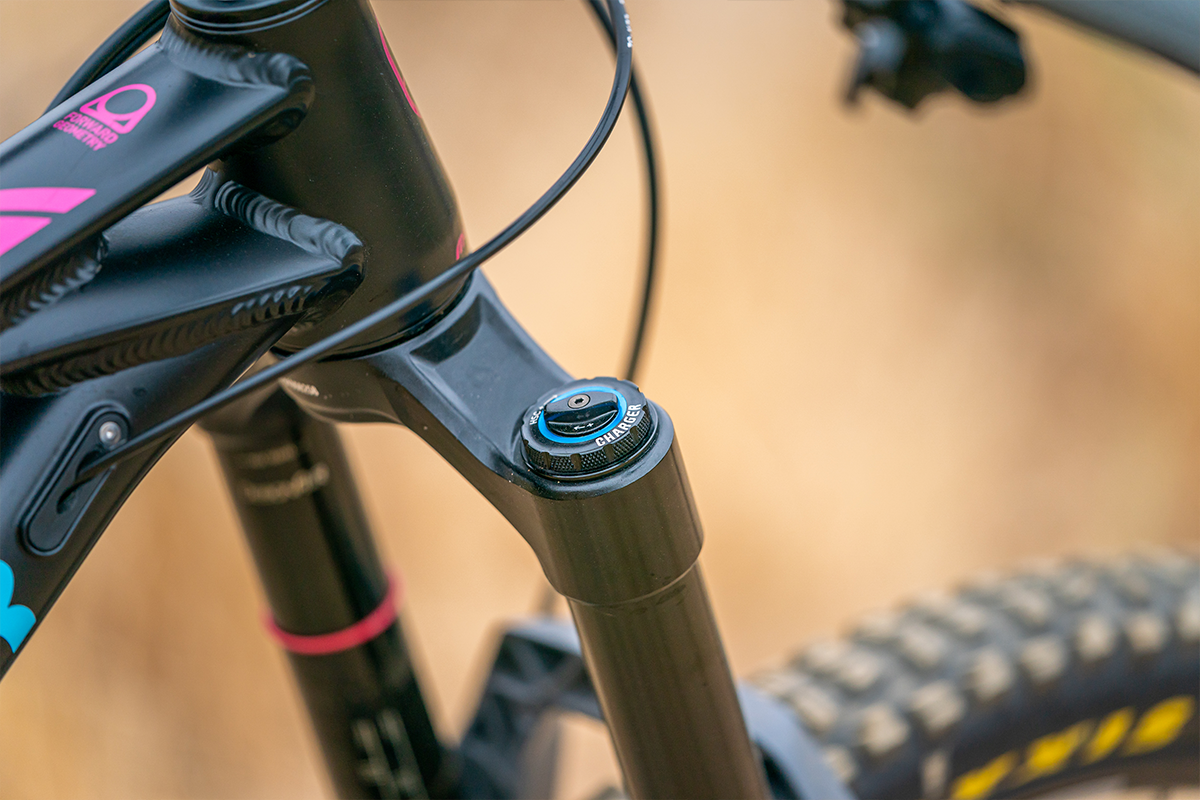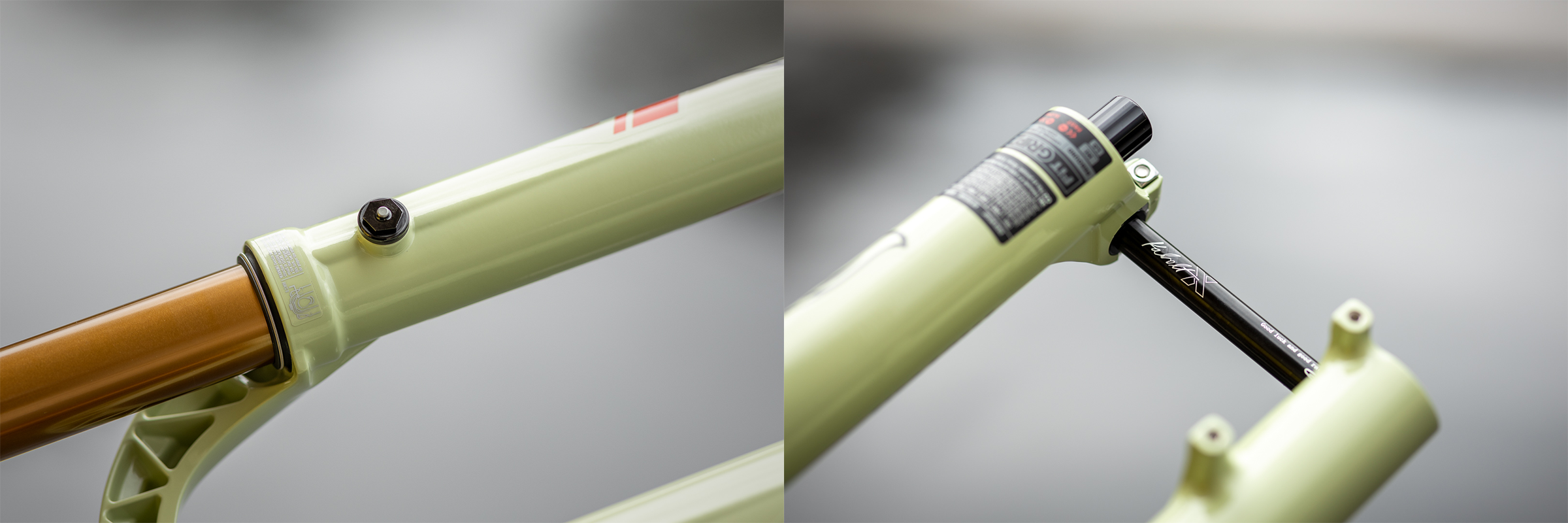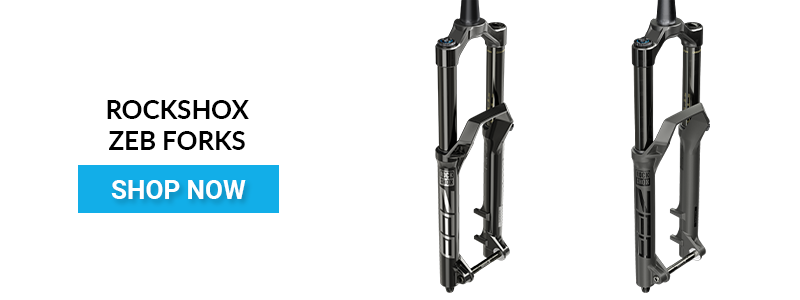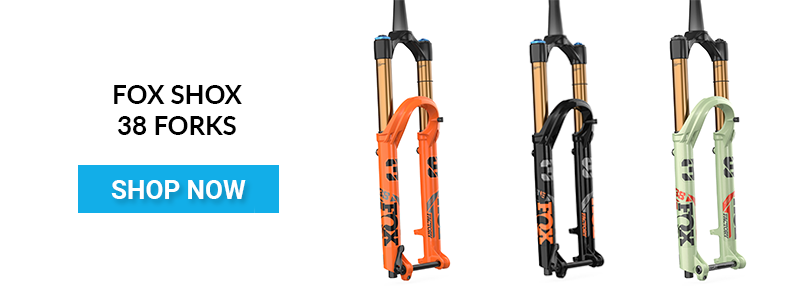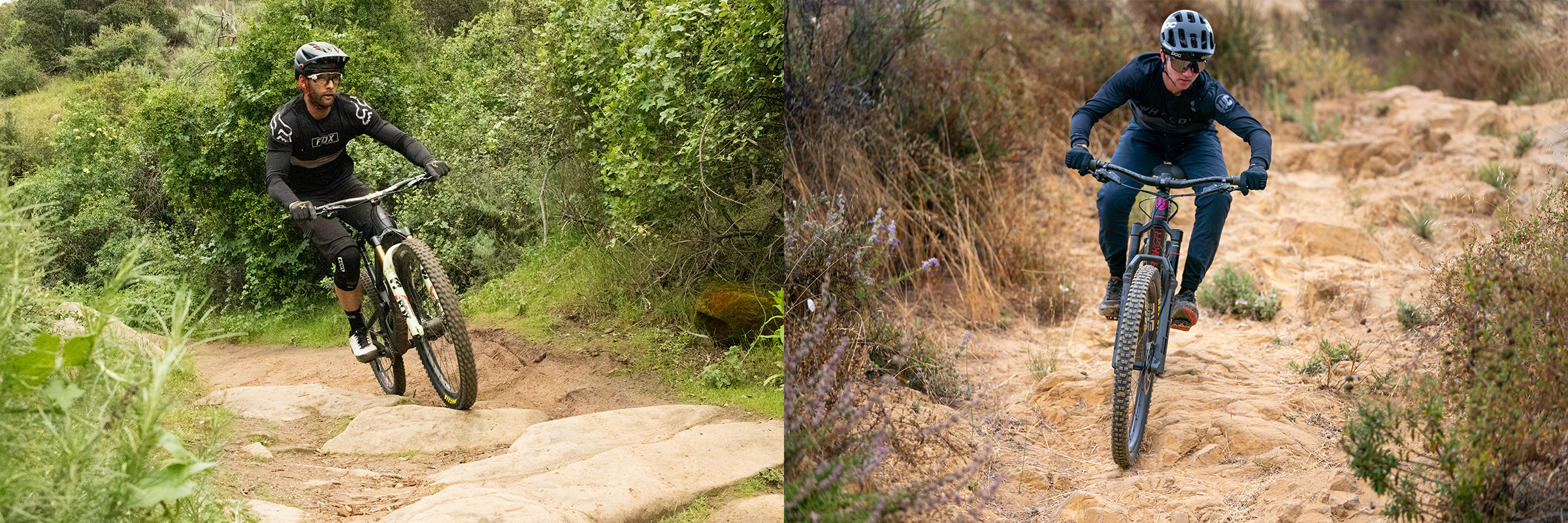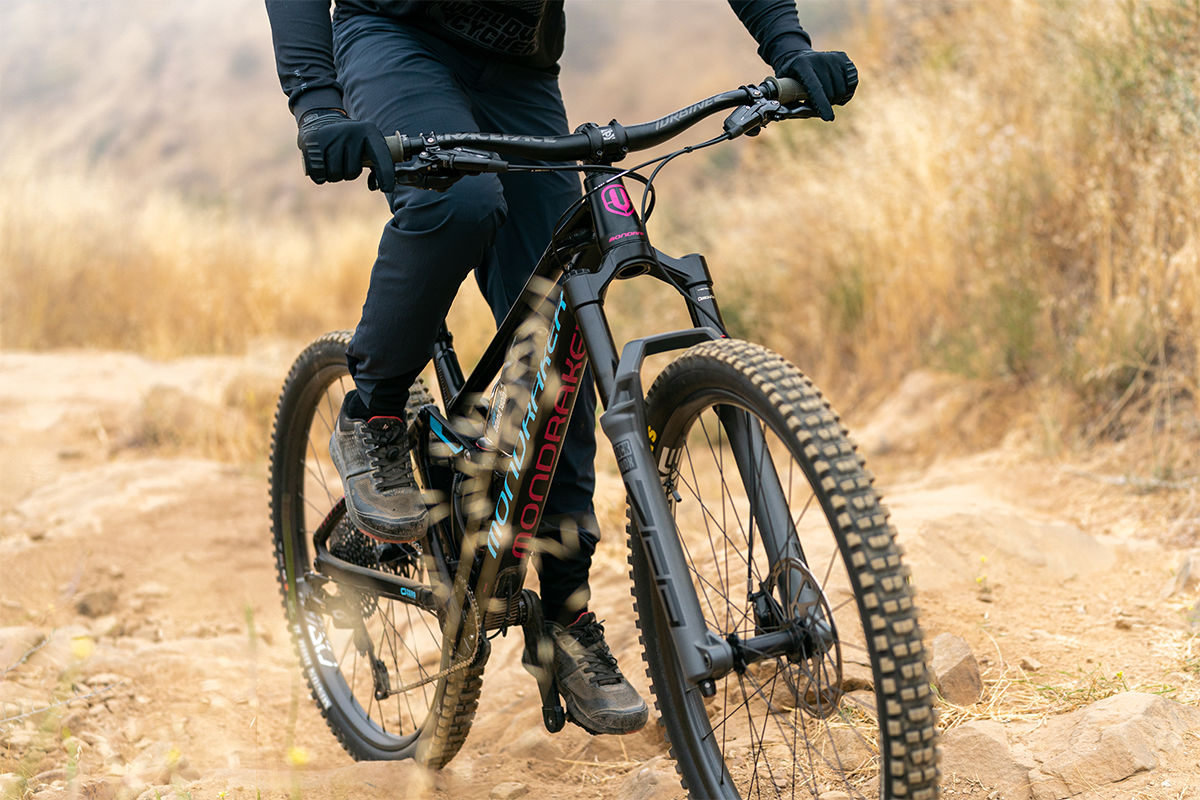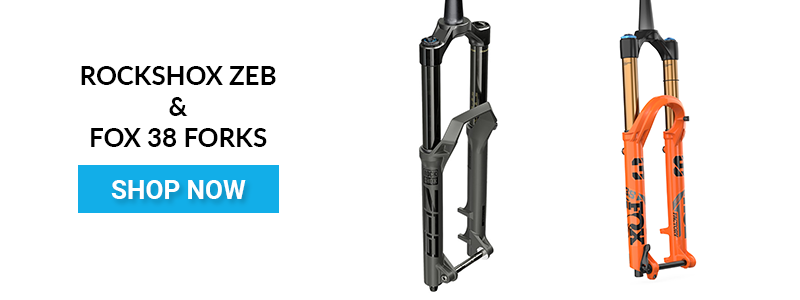- Continue Shopping
- Your Cart is Empty
Fox 38 vs RockShox ZEB - What's The Difference? [Video]
Words by: Liam Woods
Intro:
There is a new category in mountain bike suspension forks which many are calling super enduro and RockShox and Fox have jumped up their fork options to include these longer travel forks in their lineup. The RockShox ZEB and Fox 38 are the newest forks from both brands that feature 38mm upper tubes, these forks are made for the burliest trails, tested and developed with the world’s fastest riders. We have a full review and video on the Fox 38 as well as a review and video on the RockShox ZEB if you want to really get in depth about each product. In this article, we are going to discuss the similarities and differences between the two. As bikes and tracks are getting ridden harder each year, it seemed like an improvement was due. Stiffer forks not only help create less deflection on trail, but also less binding. This ultimately leads to a smoother feel throughout the travel on small and big hits.
To be fair, these bigger forks are not necessarily for everyone. Both brands are really only making them in 160-180mm travel range which is mostly suited for larger riders above the 200lbs mark or people who ride hard and really don't care about weight and want all the downhill performance they can get. Rockshox and Fox still offer the Lyrik and 36 respectively and those are still the best options for 150-160mm travel range or for riders that might not need the added weight and stiffness from the 38mm forks. Riders like Sam Hill and Richie Rude were some of the top pro’s riding these forks before they were released. As some of the top enduro riders in the world, if these forks are good enough to win races against the fastest riders on the hardest tracks, I think they are plenty good for us average folks.
Big Differences:
First is price. The RockShox ZEB retails for $999 for the top level Ultimate tier, while the Fox is a bit more expensive at $1199 for the Factory tier. That right there is a big difference and will be the deciding factor for many riders looking to upgrade.
While many of the features between the ZEB and 38 are similar, both forks have been aimed at the same style of riding with the same end goal, of course there are some differences as well. To start, each brand has their own compression and rebound damper that is much different in the way that it is tuned. The RockShox ZEB has the Charger 2.1 RC2 damper that features independent HSC and LSC with HSC having 5 clicks and LSC having 16, but only one single rebound adjustment with 16 clicks. The Fox 38 has the Grip2 which has plenty of adjustment with 22 clicks of HSC and LSC, as well as independent HSR and LSR with the HSR having 8 clicks and LSR having 22. For many riders, the RockShox will be a little easier to set up but not quite as tunable as the Fox Grip2 damper.
Another significant difference between the forks is the travel and offset options. RockShox has decided to make the ZEB go up to 190mm of travel, a huge travel option for a single crown fork, while the Fox 38 tops out at 180mm for both 29” and 27.5” wheels. While 190mm might be the outlier, it's worth noting that it can go up to that much travel. The offset options is also a hot topic right now, with Fox offering two options in both 27.5” with 44mm and 37mm offset options, and 29” with 51mm and 44mm options. RockShox made a bold move in 29” by only having one offset option at 44mm, while having the two in 27.5” of 44mm and 37mm. I am not totally sure why RockShox opted out of the 51mm, but I would assume they did the research of how many 51mm have been purchased as well as most new long travel trail bikes all ebing spec’d with the new short offset fork options and if you want a 170-190mm 29” fork you are most likely going to use the short offset version anyways.
Last but not last, we cannot overlook the use of air bleeders in the lowers and both brands take on fork axles. Fox has had air bleeders on their Fox 40 for some time now which are designed to help release pressure built up in the lowers during riding as they collect air. This possibly helps when changing elevation but I have heard both sides, some say it works, others don’t. Nonetheless, Fox found it was needed to add to both the new 38 as well as the new 2021 36 fork. It's also worth noting that you will not find these on the RockShox ZEB. Either RockShox does not think it's needed, or there might be some patent pending keeping it out of reach for RockShox, again, not 100% sure on that. What I am sure of is, both brands take the approach to their axles very differently. RockShox uses a more traditional 15mm axle style, but you have the option to use TorqueCaps on all RockShox forks. TorqueCaps are an amazing and easy upgrade to your front end to help increase the wheel to fork contact surface to improve stiffness and steering. The TorqueCaps increase the surface area to 27mm, making them cover more surface area upon contact than old 20mm trail style axles. TorqueCaps end caps are available for many hub options and are not only compatible on the new ZEB but also the Lyrik, Pike, and new SID.
Fox does not use TorqueCaps as it’s a RockShox only feature, but they also have their own take on the axle. While still using a 15mm axle, Fox has dropped the floating axle style from their Fox 40 into the 38 and 36 forks. The floating axle allows you to tighten down the wheel in the fork without binding the two lower legs together. You basically tighten down the axle to the wheel but it floats through one fork leg, you then have a clamp on the fork leg that tightens the axle to the other fork leg. This allows the fork legs to remain parallel between the two. Fox thought that when the fork legs got tightened together there was too much binding, that then makes the fork slightly skewed and can cause binding therefore creating friction in the movement of the fork. Lots of nerd stuff going on with these axle features. Much of which us average riders might not notice, but the beauty is the pro’s do and that technology makes it down to allow us to ride products much nicer than we deserve.
RockShox ZEB Specs:
- Weight: 2281g (29” / 170mm / Maxle Stealth / Uncut Steerer)
- Wheel Sizes: 27.5", 29"
- Travel: 160mm, 170mm, 180mm, 190mm
- Damper: Charger 2.1 RC2
- Offset: 38mm (27.5"), 44mm (27.5", 29")
- Upper Tube: 38mm aluminum
- DebonAir Spring
- Torque Cap compatible
- ZEB Bolt-On Fender
- Torsional Stiffness = 21.5% Stiffer
- Side Bending Stiffness = 7% Stiffer
- Fore/Aft Bending Stiffness = 2% Stiffer
- (**Lyrik vs ZEB test lab data: Both forks are 29” 180mm travel)
Fox 38 Specs:
- NEW elliptical steerer tube maximizing stiffness to weight
- NEW lower leg bleeders
- NEW air/oil channels
- NEW floating axle
- NEW arch shape offers improved head tube clearance with shorter rakes
- Matching 8-click HSC and HSR adjustment on GRIP2 forks and X2 shocks
- Damper option(s): GRIP2 with VVC FIT4, GRIP
- Updated EVOL air spring
- Inner air sleeve/cartridge tube
- Travel option(s): 160mm-180mm
- 31% stiffer transverse shear, 17% stiffer fore/aft and 38% torsionally stiffer than 36
- Wheel size(s): 27.5" and 29"
- Offset(s): 37mm, 44mm and 51mm
- 58mm crown diameter to match modern frame shape profiles
- Optional mudguard
- Factory Series models feature Genuine Kashima Coat
- Available in Factory, Performance Elite, Performance, and E-Bike models
- Starting weight: 2180 g
- MSRP USD $949 - $1199
On Trail Differences and Feel:
Long story short, both of these forks feel absolutely amazing. The Fox 38 and Rockshox ZEB both take a huge performance gain over their now little brother variants, the Fox 36 and RockShox Lyrik. Over the little brother options, the super enduro 38mm forks feel more planted, more controlled, and what I noticed the most, was the ease with which the forks got into their travel. They both seem to be very smooth off the top with great support. I think much of that is due to the stiffer chassis having less friction and binding through the fork allowing it to just work better and create a smoother feel.
Now to compare the Fox 38 vs RockShox ZEB, what we have all been waiting for. And to be honest, you might be disappointed, both forks are absolutely amazing and it's very hard to pick anything one does better than the other. Both forks are made by the two best suspension brands in the industry. I really have to nitpick the differences between the two, and some of it comes to set up and ease of set up. I think the RockShox ZEB is a bit easier to get set up and feel good. It has less settings, and I found that the recommended air pressure was very close right off the chart on the fork. The Fox 38 has more settings to get dialed in, both compression and rebound, and I found that for a lighter rider I ended up slightly under the recommended pressure on the Fox chart. If you are a rider that loves to get into small setting differences and really getting the fork tuned in, the Fox 38 has more options and would be better for that. If you are the easy set up and set and forget type of rider, then the RockShox ZEB is more your style.
The on trail differences are even smaller between the two, and for my riding weight at only 155lbs, some would argue that I am even a bit too light to justify riding either of these forks, but that is why we also get some of our riding buddies who are on the other side of 200lbs from me to also get their opinions. The Fox 38 seems to handle some of the big hits just a little bit better, the 38 remains composed under multiple hits back to back. This isn't to say the ZEB can't do that, but the 38 just feels smoother and more under control in these situations. The ZEB I think lends itself to be a bit softer off the top and might be better for some riders who choose to ride either of these forks but are a bit lighter.
Since there aren't too many differences on trial to point out, let's talk about what they both do extremely well. Both forks both sit up high in the travel and do not dive too much under braking or steep sections. Both forks also handle chunky sections well as you would expect, but what you notice more than the overall stiffness is how much more controllable the forks are, as there is less flex and less deflection helping you keep your line just that much better.
Final Thoughts:
Super Enduro? The RockShox ZEB and Fox 38 create a whole new suspension fork category made for the longest travel bikes, going down the roughest, steepest trails. With riders like Richie Rude and Same Hill helping in the development of these forks, it's no doubt they are as good as they can get. With 38mm upper tubes, these forks are stiff, smooth, and can handle anything us normal riders throw at them. With little differences between the two, the biggest difference we think is price, with the RockShox ZEB at $999 and the Fox 38 at $1199 for the top models, the rest is pretty similar. What would you choose?
This article was written / authored by Liam Woods. Liam has been in the bicycle industry for over 10 years as a racer, professional mechanic, service manager and as of late, media and content creator. Liam has ridden thousands of different bikes, ridden countless components, tested endless MTB apparel of all kinds and written reviews on it all. He's a key piece to the Worldwide Cyclery "All Things MTB" content creation puzzle. He also makes consistent appearances on the Worldwide Cyclery YouTube channel and Instagram.
If you are one strange human that would like to read a transcript of the video above, continue reading below!
Ladies and gentlemen today we are going to compare the two beefy 38mm stanchion super enduro forks from fox and rockshox the 38 versus the zeb we're going to get into all the specs and details and what's different and mostly what's the same between these things and then how do they feel differently out on the trail well we made an in-depth video on each one of these forks individually because they're kind of big news right they're the latest and greatest super enduro forks from each of the leading dominant 800 pound gorillas in the mountain bike suspension world fox shocks and rock shock um why i'm calling them super enduro i that's kind of just the term i made it myself i think that you know previously we had the lyrik from rockshock and the 36 from fox and both brands are really trying to push the limits of what they can do with mountain bike suspension and most in particular for their fastest enduro racers right so enduro racing is becoming a huge sport these days in the mountain bike world and the guys doing it are pushing those bikes which are longer travel single crown fork bikes that they pedal uphill and go super fast on downhill they're pushing those things to the absolute limit and the faster you go the more suspension and the better suspension you need and the more fine-tuned it needs to be and the kind of stiffer your bike needs to be and handle so a lot of people commented on these forks and frankly i kind of agree right like each one of these things is not for everyone right i mean if you're riding a long travel enduro bike and you're like a a larger rider that kind of really enjoys a stiff feeling fork or simply you're just a really advanced rider and you're riding really fast the faster you go and the bigger you are the more you're going to notice the actual differences and benefits of a 38 mil stanchion really stiff controlled fork just like you'd notice the differences of riding a trail bike and a downhill bike on the same exact trail right one is just more purpose-built for what you're doing with it so both of these brands are coming out and innovating their suspension and i would say you know sometimes suspension innovation kind of trends more towards hey we innovated this for the average rider who's out there riding mountain bikes as a weekend warrior and sometimes it trends towards hey we innovated this because you know we have professional athletes that are the best in the world and they need this and i think that's kind of where both of these things came from the cool thing is us as average riders get to enjoy them if we like as well so without further ado what's different what's similar about these well to be honest like they're both super enduro 38 mil stanchion forks and there's probably a lot more that's similar than that's different so i'm going to try to focus mostly on the differences and if you really want to get nerdy on these things like i mentioned we have an individual video for each one of these forks which accompanies with an in-depth article with all the specs and details and everything so to talk about some of the key differences between these things that are probably something you're going to want to consider if you're considering buying one of these things um right off the bat to me is price point right so rock shock is coming in at $699 to $999 so $999 being their zeb ultimate like the premium creme de la creme top of the model zeb and fox is starting at $949 for the performance series and going up to $1199 so $999 versus $1199 there's a pretty sizable difference in price right there so that's a pretty big difference that i think is something to consider if you're looking at both of these forks in terms of weight um there's claimed weights all over the place for every mountain bike part out there and claimed weights are confusing because it's like well is it a 29 or a 27.5 is the steer uncut is it not both of these are 29ers in 170 mil travel steer is the same length we weighed them ourselves you can see that right now five pounds one ounce [Music]
two ounces lighter and the zeb won by two ounces
[Music] it was four pounds 15 ounces versus five pounds one ounce of the 38 that's two ounces is kind of negligible in my opinion when it comes to a fork um but so that's weight what else is different between these things well the 38 is not available in 190 mil travel the zeb is they make a 190 mil travel single crown zeb which is pretty badass um so if you're looking for a 190 mil travel single crown fork you kind of only have to go with the zeb next up dual position air so that's something that uh rockshox has been doing a long time and actually fox did a long time ago as well it used to be a lot more popular and then bike geometry got different but now it's coming back and it's came back with the zeb in particular for e-bikes right so the e-bike variant of the zeb has a dual position feature and it goes from 150 to 180. so what that is if you don't remember those forks um basically you always ride the thing at its max travel so in 180 but when you're going uphill when you're pedaling that e-bike up a hill you can flick a knob get that thing down to 150 it lowers the front end of your bike by 30 millimeters which puts it in a much more comfortable climbing position kind of keeps that front wheel on the ground keeps your body weight leaned forward so you don't feel like you're constantly popping wheelies which is a problem with long travel bikes pedaling up a hill and it's definitely a problem with an e-bike because you have a lot of power to the rear wheel so that's an interesting feature that rockshox came back with for the zeb um each brand has sort of their like e-bike-owned specific things that have their own various tunes and stuff so if you are an e-biker look into that um they both kind of work great for e-bikes and are e-bike approved and have their own e-bike variants um the zeb in particular has the dual position whereas the fox 38 does not um let's see what else is different well the only other different things are not that big of a deal but i'll get into them so the axles are a little bit different rock shock uses what they call torque caps so both of these have 15 by 110 axles rockshox uses torque caps on that 15 by 110 axle and that is basically the surface area around that 15mm axle is much larger right so you need torque cap end caps on your front hub to take advantage of this and it'll give you a huge amount of surface area around that axle which increases stiffness a ton and it's actually pretty noticeable on my trail bike going uh actually with a pike going from a front wheel that doesn't have those torque caps on it to going well with it what that did have it did you don't even think these guys are good you can notice a pretty big difference because there is a lot more surface area so that's kind of rockshox answer to why they don't use 20 millimeter axles on these enduro and trail bike forks and how you can kind of get a ton of stiffness there fox does not have that it's just the traditional 15 by 110 axle but a fancy trick that they do have in their axle they call it a floating axle so the way that this works is you can get it dialed in so that you can tighten everything down and the lowers don't have any flex so the concept here is that you know no matter how close they can engineer this right like there's always going to be some amount of play some tolerance where there's going to be a little bit of flex when you tighten that front wheel and it clamps down on the hub and like you can see that flex right that flex puts these lowers at an angle and that apparently causes friction right [Music] so in order to reduce that friction fox came out with this floating axle to basically keep the lowers perfectly straight is that a monumental change or a small change i don't know i'll leave that up to you to decide but nonetheless like we've gotten so far with everything in the mountain bike world especially suspension that the little things these brands are you know engineering these days are small gains one by one to really make the things just iterate better and better and better every year and that's kind of the difference between the front axle on this thing and the zeb another thing speaking of like small interesting little gains fox has these air bleeders so the idea here is that the air pressure in the lowers of the fork not the air spring but the lowers of the fork will actually increase if you change elevation right so that is actually wrong originally i've thought that these little air bleeders more had to do with elevation pressure but i've since learned from a good friend of mine who is a former suspension engineer at rockshox and now a bike frame engineer that elevation actually doesn't affect us too much because it can't expand so what it is why you need these you do build up air pressure in the lowers but that actually just happens naturally from the fork cycling and from the fork cycling it basically can create air pressure in here that makes it not feel right and you kind of want that to be equalized it's more of an issue on longer travel forks which is why basically every dirt bike out there motocross bike has some type of like air bleeder system on it and why fox had these on their 40 their 8 inch travel downhill fork before they moved it to the 38 and 36 so more relevant for longer travel forks that are getting ridden faster with harder hits and it's not necessarily because of elevation it's more just because of when it cycles it somehow sort of pulls air in here and creates pressure and needs to be equalized you can do this yourself with a thin zip tie if you kind of drop it into the dust seal and pull it down there it'll actually like equalize it on a normal fork that's a trick that some people do whether that's super necessary or not or if anyone would ever tell the difference between you know riding this fork with there being any air built up in here and then if you equalized it that's up for debate but either way it is more important on longer travel forks air does build up in there and that's why fox put those on there both forks of course have a single rebound adjustment and a independent high and low speed compression adjustment on the damper side they both utilize air spring tokens to reduce the air volume if you want to change how progressive the suspension is fox has an elliptical steerer tube so again that's a stiffness thing we unfortunately don't have the equipment to really like put these things down to a extensive scientific test to see which one's stiffer than the next but kind of the verdict is after riding them the stiffness is pretty much equal um they're both considerably stiffer than uh their counterparts right so the the zeb being uh like the evolution bridging the gap between the lyrik and the boxer and the 38 bridging the gap between the 36 and the 40. way stiffer than a 36 ways different than a lyrik again you're going to notice that stiffness the faster you're going the harder you're riding and the heavier you are so keep that in mind another small difference i will never stop talking the zeb uses a 200 millimeter rotor post mount so that's the small size rotor that you can fit on this fork i think you can go up like 220 or 230 on both these things the 38 uses a 180 post mount so if you do prefer a 180 rotor you can actually fit it on here and if you do prefer a 200 rotor you will need an adapter whereas the zeb you won't so um that is really kind of like your your spec details that are different between these two things and well now let's talk about how they actually feel on the trail
[Music]
on trail performance i wish i had better news for you guys um i i think you know like i've mentioned suspension in the mountain bike world has innovated very far right now and it's very very optimized and both of these brands right they're like the the two big gorillas in the industry in terms of just innovation and performance hands down and they're both kind of going for the same thing right i mean they wanted this fork to work for that super super enduro rider that i mentioned and the performance they're going for is kind of what you know it's the same it's the same they have the same goal right for for that type of racer and they want like great small bulb absorption they wanted to like dive into the travel and have mid-stroke support they wanted to be as progressive and have that progressivity be tunable via tokens they want independent high and low speed compression so they're kind of they kind of have like the same overarching goal and i'll be dead honest with you guys like i cannot pick one of these over the other you know i think if you rode them blindfolded it would be really really hard to tell which one you were on um i i wish i had different news for you but they both work phenomenally well i kind of got more into the performance of each of them in their individual videos but like i said like each brand kind of has their like very similar if not identical goals of what they're going for in terms of how they want that fork to feel they don't have like opposing ideologies one of them doesn't think it should feel like this on trail versus this on trail like they have pretty much the same mentality when it comes to you know what a mountain bike fork should feel like for a world-class enduro racer don't you repeat yourself you know that um on a you know a modern enduro bike so they feel amazing they're incredible definitely a step up from the 36 definitely a step up from the lyric totally equal side by side and if i you know honestly if i were to tell you it felt any different on trail it would be bs and i and i think a lot of things in the mountain bike world when you're comparing such similar products you really get into this like head case placebo effect and you're kind of like overthinking stuff and inventing things feeling differently in your own head i think that's pretty common in mountain bike reviews and i try to avoid that myself and i try to like not put in other variables like using the same bike and same tires and same trail and just switching one variable at a time so yeah they're they're both neck and neck so if you think there's a big performance difference between the two there just isn't so whichever one you end up going with uh it's a great choice it's they're both amazing forks that are going to work super well for that category that they're intended for being like super enduro long travel fast you know fork um yeah there you go well i hope that was valuable for you guys and uh useful if you're considering one of these super enduro forks drop a comment below rockshoxzeb or fox 38 i'm very curious and also please hit that thumbs up button if you've made it this far in the video and please subscribe to the channel i think you will love all the mountain bike content we post because if you've watched this video comparing two enduro forks for this long you're really really into this so you should definitely subscribe alright see you later


